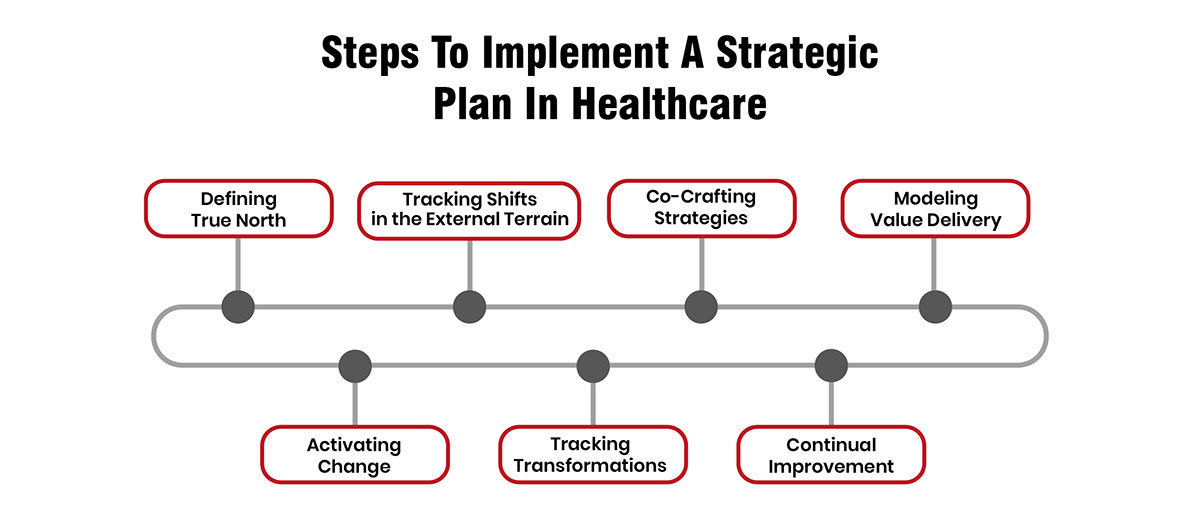Navigating Healthcare Transformation through Agile Strategy Planning
 March 22, 2024
March 22, 2024
The healthcare arena stands at an inflection point today in 2024, on the cusp of pivotal tech-led changes. While innovation lights up new possibilities, it also casts shadows of disruption. For healthcare organizations to thrive amidst the churn, nimble strategy planning becomes paramount.
This calls for a rethink of conventional strategic planning playbooks to craft more responsive systems. ecosystem connectivity, allowing enriched access to networks and skills. Mastering a few key principles can make healthcare strategies more emergent, collaborative, and insight-driven.
Let us walk through the building blocks to create living strategic plans that shape-shifts as per market cues.
What is Strategic Planning in Healthcare?
Healthcare strategic planning involves clearly defining an organization's vision, mission, and values, then analyzing internal and external environments to establish data-driven goals, priorities, and implementation tactics. This structured approach serves as a dynamic roadmap for optimizing decisions and resource allocation to reach an intended future state.
Intentional strategy development allows health systems to tackle specific challenges in fostering healthier communities with greater efficiency and impact. For example, conducting root cause analyses of high hospital readmission rates can inform targeted interventions like streamlined care coordination and at-home services for vulnerable patients. Tracking corresponding outcomes provides evidence for refinement.
Strategic workforce planning also utilizes analytics to predict emerging needs, guide the realignment of staffing models and upskill programs, and provide mixes to match community risk factors and utilization trends. Meanwhile, exploring options like telehealth and retail clinics opens additional access points on the care continuum.
Financially, evaluating new value-based payment models, service line expansions, and cost-saving technologies keeps health systems competitive and economically viable. This fiscal resilience enables reinvestment into facilities, patient experience upgrades, and payment assistance funds to uphold the mission.
In total, dedicated strategic planning supports healthcare organizations in taking a proactive, offensive stance to address essential goals rather than simply reacting to external forces. Defining the ideal future and plotting an adaptable path to achieve it is what effective healthcare strategy is all about, even in the face of uncertainty. With clear sight, purpose, and partnership, health systems can transform to power thriving communities.
Why is Strategic Planning Important in Healthcare?
Strategic planning is a pivotal activity for healthcare organizations seeking to provide high-value, sustainable care amidst complexity and change. This structured approach to defining vision, analyzing contexts, and establishing focused priorities delivers manifold benefits that strengthen health systems.
Boosts Financial Health and Sustainability
- Evaluates new revenue streams and cost-saving measures for long-term economic viability
- Guides wise resource allocation aligned with organizational priorities
- Reveals operational inefficiencies to target through process improvements
- Smooths unpredictable volume fluctuations via growth initiatives
Enhances Workforce Engagement and Retention
- Articulates inspirational vision and involves staff in planning for motivation
- Surfaces pain points around excessive workloads for intervention
- Encourages collaboration across teams by linking efforts to shared goals
- Instills employee value and purpose by conveying how all roles contribute
Drives Organizational Alignment and Strategy Execution
- Ensures stakeholder participation aligns priorities with an overarching strategy
- Reduces confusion by providing clear insight into the collective mission
- Enables successful implementation by securing buy-in across levels
- Fosters unified effort towards common objectives for greater impact
How To Implement a Strategic Plan in Healthcare
Implementing a strategic plan in healthcare requires careful planning and execution. Learn the essential steps here.

-
1.
Defining True North
The first step towards effective strategic planning involves framing an inspiring vision and purpose that resonates with internal and external stakeholders. This true north acts as the guiding beacon while navigating future uncertainties.
Articulating a higher collective cause galvanizes teams for the change journey ahead. It also clarifies how the organization contributes value to ecosystem partners, which is pivotal in cementing durable win-win relationships.
-
2.
Tracking Shifts in the External Terrain
While an inner compass provides direction, scanning the exterior landscape reveals clues that warrant strategy pivots.
Macro-environment tracking tools like PESTEL can assess disruption risks across political, economic, sociocultural, technological, environmental, and legal dimensions. Emergent competitors also use merit monitoring to identify growth opportunities the organization can harness through new service lines or channel partnerships devoid of the constraints of legacy systems.
Such external orientation prevents strategic plans from turning rigid, ensuring timely adaptations stay aligned with market transitions.
-
3.
Co-Crafting Strategies
Top-down strategy planning in healthcare is giving way to collaborative models that leverage inputs from cross-functional teams. This prevents plans from getting skewed by isolated perspectives at the leadership level.
Driving inclusive roundtables to shape strategy also fosters greater ownership during execution by participants. Frontline insights surface ground realities that leaders can miss, revealing challenges and windows for creating distinctive value.
Getting teams across clinical, operations, finance, and technology to co-create strategy blueprints breaks silos and enables balanced plans. The engagement process itself builds bonds that ease implementation down the line.
-
4.
Modeling Value Delivery
While strategic planning in healthcare workshops generates plenty of ideas, translating brainstorming sessions into executable projects calls for a structured approach.
The Theory of Change presents a useful framework that creates a causal pathway between current challenges and desired outcomes. This flowchart visually depicts how deploying key resources and capabilities (inputs) can activate processes and activities (interventions) to trigger results (outputs) that reshape metrics around customer satisfaction, clinical excellence, or revenue goals (outcomes).
Such logic models based on if-then relationships between strategic levers and targeted impacts help build consensus around transformations that can achieve end objectives. Testing assumptions underlying these hypotheses before committing capital also de-risks failure.
-
5.
Activating Change
With strategic priorities defined, creating executable roadmaps is next. Large transformative initiatives require disassembly into modular programs and projects to activate outcomes.
Driving organization-wide alignment calls for goals and metrics to cascade across departments. Visually mapping interdependencies between diverse workstreams through tools like Alignment Mapping also smooths engagement across silos enabling concerted progress.
Bottom-up projects bubbling from frontline innovation can further kindle organization-wide movement. Providing incremental budgets for small-scale experiments meeting cost-benefit viability criteria allows for testing transformational ideas.
-
6.
Tracking Transformations
As healthcare strategies get operationalized, monitoring momentum becomes paramount without micromanaging execution.
HR dashboards aggregating metrics across projects foster data-led dialog while flagging deviations from the plan. Custom reports benchmark progress against relevant comparators, allowing timely course corrections.
Periodically reviewing indicator trends in relation to targets also allows strategic reprioritization of misfiring initiatives. Pivoting funding and resources to initiatives demonstrating traction is key to portfolio optimization.
-
7.
Continual Improvement
In dynamic healthcare environments, strategy planning must evolve continually instead of rigid revisits on annual cycles. While structured annual strategy reviews lend stability of direction, regular pulse checks and incremental enhancements finesse strategic trajectories.
Post-implementation reviews assessing outcomes feed learnings into new planning cycles while closing gaps. Keeping strategy planning on a rolling calendar allows for the factoring of emerging risks and possibilities as signals emerge during execution instead of mass yearly revisions.
Such continual reorientation alone keeps strategic plans contextually updated and resilient amid external disruptions.
Conclusion
Manual coordination across such multilayered strategy planning activities slows organizations down. Purpose-built strategy execution software rationalizes enterprise-wide alignment, accountability, and insights while compressing cycle times.
Healthcare organizations ready to build sustainable futures need emergent strategy planning capabilities to continually adapt and stay ahead of change. Mastering the fundamentals of sensing environmental shifts, co-creating inclusive plans, orchestrating aligned execution, and dynamically tracking outcomes fosters the nimbleness imperative to navigate industry transformation.
With a sharper focus on people supported by technology, it is possible to elevate healthcare far beyond clinical quality to human-centered experiences.


